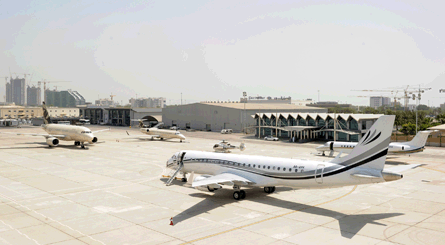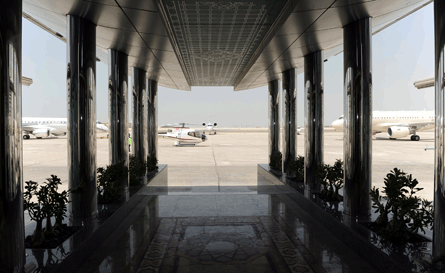From a spot of cracked paint on the oak panel door of the VIP terminal to the state of the flower beds, Mohammed Al Bulooki overlooks no flawed detail in his quest to turn a former military airbase on the edge of downtown Abu Dhabi into one of the world's leading business aviation airports.
Abu Dhabi Airports (ADAC) has given the vice-president of the newly rebranded Al Bateen Executive airport a goal - and budget - to create a VIP gateway to the nation to rival Farnborough, Le Bourget and Teterboro in London, Paris and New York and convince operators and service providers to make it their base.
Private aviation flights have been operating from Al Bateen for several years - the city's main airport until 1982 is home to charter operators Al Jaber Aviation, Falcon Aviation and Prestige Jet as well as a number of brokers, and has VIP and executive aviation terminals. However, in recent decades the airport has been very much dominated by the military, with drab buildings and a gatehouse guarded by unsmiling service personnel.
 |
|---|
© Al Bateen AirportAl Bateen Executive airport has the budget to achieve its aim of emulating the world's leading business aviation terminals |
Although it is still the base of the United Arab Emirates air force's Lockheed Martin C-130 humanitarian aid and search-and-rescue helicopter fleets, ADAC formally took over the airport in late 2008 and since then the air force has been scaling back its activities. Its departure in quarter three next year will clear the way for a massive infrastructure programme, which will include new hangars, a crew hotel, a refurbished private terminal and rebuilt control tower.
BENCHMARK
"Our objective is to be one of the world's best private airports," says Al Bulooki. "We have benchmarked ourselves against the leaders in the field, including Farnborough, which is without a doubt the number one airport."
When Formula 1's aristocracy arrived in Abu Dhabi in November for the Grand Prix - held at the nearby Yas Island circuit - most of them did so through Al Bateen rather than the international airport, 30km (18 miles) outside the city centre, Al Bateen having waived its landing and parking fees for the duration of the event.
The high-profile exercise was important to "help get the word out that this is the place to be", says Al Bulooki, who has appointed business aviation veteran Steve Jones, who used to run London Oxford airport, as general manager.
Aircraft movements this year will be 7,800 - almost 90% of them jets based at Al Bateen - but with this figure increasing by almost a third every quarter, Al Bulooki is confident 2011 traffic will be double that. The airport's recent approval for instrument landing system operations will help boost its appeal, he says. "People are getting to know about Al Bateen."
Infrastructure - or at least space - is not something Al Bulooki is short of. The airport has a 3,000m (9,800ft) runway and parking for 50 aircraft. However, the Gulf's unforgiving summer climate means that hangarage, or at least shelter from the Sun, is at a premium and Al Bateen is in the process of converting redundant military hangars into holding areas for business jets. More will be built in a second phase of the development.
 |
|---|
© Al Bateen AirportADAC wants Al Bateen to be the undisputed gateway to the Gulf for VIP travellers |
ADAC itself will fund much of the project, with the aim of attracting third-party operators and service providers to build some of the new infrastructure, even if it finds some of them competing with its own facilities. "We want maintenance providers, brokers, anyone who will add value to the airport," says Al Bulooki.
A fuel farm will be built and a military barracks will be converted into a basic 50-room hotel for crew and students at the newly built Gulf Centre for Aviation Studies, whose facility occupies part of the airport site.
ADAC will also refurbish the rather utilitarian executive aviation terminal - used by oil rig crews among others - with duty-free shops, a pharmacy and banking facilities for crew and passengers. The very Arabic-themed luxury terminal next door will also be given a more contemporary feel.
FOLIAGE MAKEOVER
Even the foliage will get a makeover - Al Bulooki says since taking the job he has had to become an expert in everything from horticulture to furniture - as passengers coming off a jet into the often searingly hot Abu Dhabi climate "like to see greenery as it helps them cool off".
But for all its planned facilities it is Al Bateen's location that will be its biggest selling feature with premium passengers, maintains Al Bulooki. Situated just 10km from the business district and in the middle of an area that is being extensively developed with upmarket housing, offices and hotels as part of the city's strategic plan, Al Bateen, he says, will be popular with clients for whom minutes really matter. "People will be shocked" when they realise how much driving time they will save over a journey to the (also ADAC-run) Abu Dhabi International.
And, as with almost everything in the ambitious emirate, Al Bateen's development is not purely about generating revenue from aviation users, grudgingly paying high fees because there is no alternative: it is part of a broader, joined-up plan to bring high-end investment and tourism into Abu Dhabi.
"We think differently than some places that see private aviation as a way to make money. That's not how to attract business," says Al Bulooki. "We are about supporting business aviation. We put aeronautical revenues at the bottom of our priorities."
Source: Flight International
















